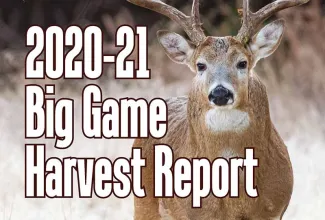
A Season For The Record Books
Deer Hunters Surge Past Previous Marks for Participation and Harvest
By Dallas Barber, ODWC Big-Game Biologist, and Emily Clark, Big-Game Technician
Photo by Larry D. Brown/Readers' Photo Showcase 2020
The 2020-21 Oklahoma big-game hunting seasons were an exceptional success, providing hunters abundant opportunities with great habitat along with healthy and robust herds. And Oklahoma hunters took advantage of the opportunities, breaking many harvest records across the state, in more ways than one.
Deer season resulted in record-shattering numbers for hunter participation and harvest. Elk hunting saw a substantial increase in harvest. And pronghorn hunting remains a highly sought-after and successful quarry to hunt.
These are good times for a big-game hunter in Oklahoma!
Deer Hunting Seasons
A total of 126,290 deer were harvested during the 2020-21 seasons, the most ever. More importantly, antlerless harvest made up 43 percent of the total harvest, the highest since 2010 and a 5 percent increase from the 2019-20 season. Figure 1 shows the total number of deer harvested for each year from 2004 to the present.
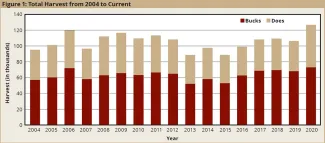
Gun season continued as the most popular deer hunting season. Gun hunters took 73,542 deer with a modern firearm, setting a new harvest record. This figure includes the holiday antlerless season and the youth season.
Muzzleloader hunters bumped up their harvest from the 2019-20 season by almost 1,000, reporting a total 17,411 deer taken.
And it was no surprise that archery hunters set another season harvest record with 35,337 deer taken. Archery hunting has been on an upward trend over the past handful of years. Figure 2 shows success rates among the various hunting methods, while Figure 3 represents individual seasons and their respective harvests.
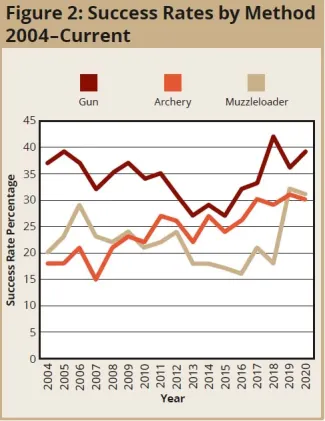

Oklahoma deer hunters are able to try their luck across a wide diversity of habitat types. Along with the diversity comes varying levels of deer habitat quality. While some counties enjoy large tracts of public land that is rich with wildlife, others do not. To even the playing field, Table 1 shows deer harvest totals by county without including the deer taken on public hunting areas including ODWC’s wildlife management areas (WMAs).
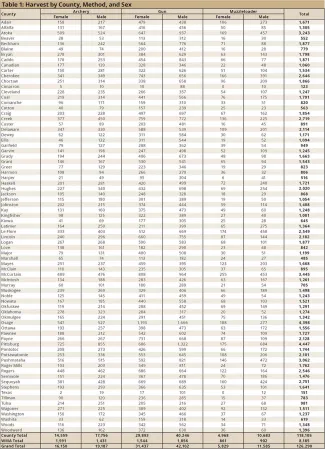
Due to their large size, the top three counties for deer harvest came in as expected. Pittsburg County landed in first place with 4,447 deer harvested. Osage County was closely behind with 4,398 deer harvested. McCurtain County landed in third place with 3,445 deer taken.
WMAs and other ODWC-managed public lands make up a small percentage (about 3 percent) of Oklahoma’s land area. But these areas account- ed for 6.5 percent of the overall deer harvest. Details of harvest on public lands are compiled in Table 2.
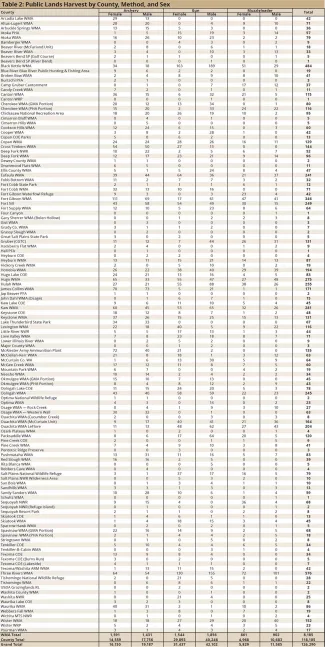
Archery Season
The 2020-21 archery season set another harvest record of 35,337 deer, which was almost 5,000 more than the previous record set during the 2019-20 season. These 35,337 deer made up for 28 percent of total deer harvest for all seasons. Bucks accounted for 54.3 percent of total archery harvest, with antlerless deer making up the other 45.7 percent.
Also notable is that archery hunting continues to grow in popularity. The annual Game Harvest Survey (GHS), a long-standing ODWC scientific survey that tracks hunter participation and success, estimated a new record in archery participation of 141,472 hunters who chased deer in 2020-21 with some form of archery gear.
Regulations continued to be unchanged for archery season, which was open from Oct. 1, 2020, through Jan. 15, 2021. The bag limit was six deer, but no more than two of those could be antlered. A breakdown of harvest numbers by sex and by week can be seen in Figure 4. Archery hunter participation and harvest from years past are represented in Figure 5.
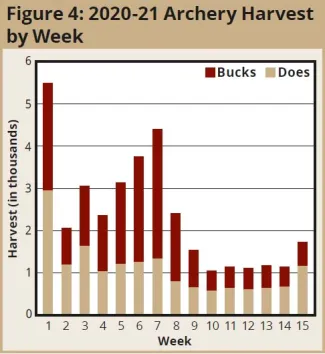
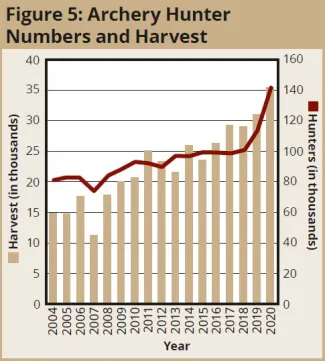
Muzzleloader Season
Muzzleloader hunters were in the field from Oct. 24 through Nov. 1, attempting to fill a bag limit of four deer, of which no more than one could be antlered. Additional antlerless harvest was encouraged by the liberalization of antlerless bag limits offered in specific Deer Antlerless Zones as shown in Figure 11.
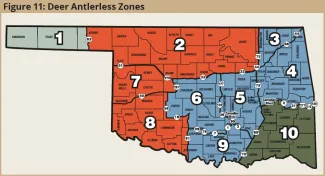
Estimates from the GHS show that about 97,000 hunters took advantage of the under-utilized muzzleloader hunting method. But participation was the highest since 2009. The result was 17,414 deer harvested, the most for muzzleloaders since 2012. Antlered deer totaled for 67 percent of harvest, while antlerless made up the remaining 33 percent. A breakdown of harvest by day can be seen in Figure 6, while hunter harvest and numbers from previous years are displayed in Figure 7.
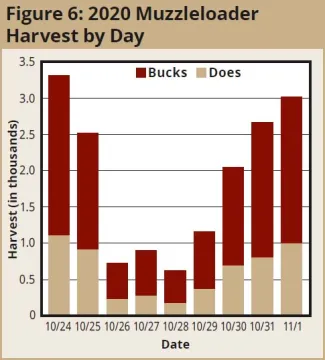
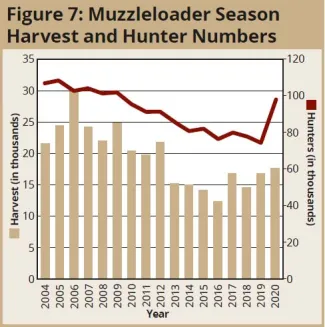
Gun Season
Hunters aiming to harvest deer with a gun could go afield from Nov. 21 through Dec. 6, 2020. The gun season brought some small changes to the bag limit structure. The bag limit was changed to four, but only one of those could be antlered. There were also some antlerless harvest changes within Antlerless Deer Zones, which can be seen in Figure 11.
An estimated 218,548 hunters managed to harvest 73,542 deer with a gun. These are record-setting numbers in both categories. Figure 8 and Figure 9 show harvest by sex and day, along with harvest and participation from years past.
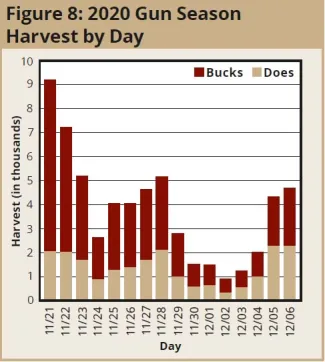
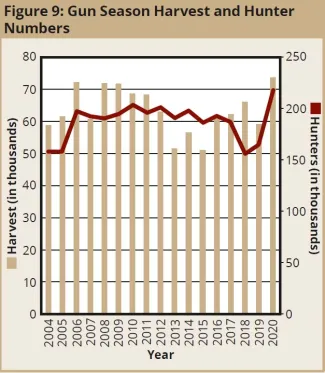
The holiday antlerless gun season saw an expansion of season dates, running from Dec. 18 through Dec. 31, 2020. Harvest during this expanded season increased to 6,786 deer, almost doubling last year’s total. Figure 10 shows holiday antlerless gun season harvest totals from 2015 to the present.
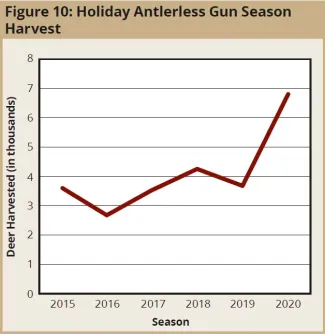
The youth deer gun season ran for three days from Oct. 16 through Oct. 18, 2020 and resulted in the harvest of 4,465 deer. Antlered harvest made up 57 percent of the total.
Deer Hear Age Structure
The Wildlife Department gathers age data from the Deer Management Assistance Program (DMAP), local deer processors, taxidermists, and the “Age My Deer” program at wildlifedepartment.com. Typically the Department would enlist students to assist in collecting deer jaws from various processors and taxidermists. With 2020’s COVID-19 restrictions, this year’s data consists of only DMAP, controlled hunts, and “Age My Deer” information.
The data provide information regarding age structure within the herd, a key component when looking at overall herd health. Figure 12 and Figure 13 display age at harvest for antlered and antlerless deer.
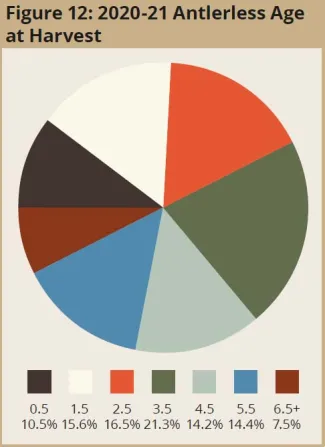
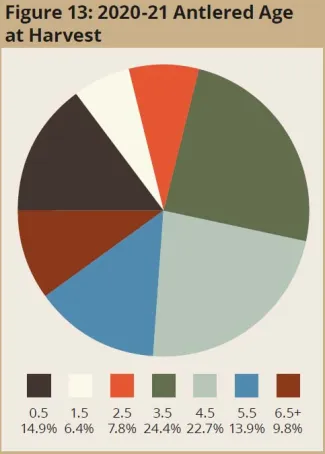
Conclusions (Deer)
2020 was a year to remember. As a pandemic swept around the globe and left many people frightened and homebound, the outdoors awaited with open arms. Many hunters used Oklahoma’s plentiful resources to put clean, organic protein on the table for their families.
The state’s deer hunters set records for total harvest, archery harvest, gun harvest, and participation for both archery and gun seasons.
More importantly for the health of the state’s deer herd, hunters reached the Wildlife Department’s antlerless harvest goal of 40 to 45 percent of total harvest for the first time since 2015.
The ball was placed in the hunters’ court, and they answered the rally call of “Hunters in the Know … Take a Doe!” The quality of bucks being harvested continues to impress hunters not only in this state but across the country. This has all been accomplished through voluntary restraint. Using science-based regulations and enlist- ing hunters as boots-on-the-ground deer managers, ODWC continues to strive toward the goal of a balanced deer herd based on available habitat and healthy age structures.
I wish all of you good health and good luck during the upcoming 2021-22 seasons. And remember this: Every time you decide to pull the trigger or release an arrow, you're making a deer management decision that impacts your local populations. So, keep in mind that “Hunters in the Know … Let Young Bucks Grow — and Take a Doe!”
Hunters Must Follow Oklahoma Import Rules to Prevent CWD
Chronic wasting disease (CWD) affects cervid species including deer, elk and moose. This always fatal, contagious, neurological disease continues to spread across much of the United States and Canada. It causes emaciation, loss of control of bodily functions, abnormal behavior, and ultimately death.
CWD has yet to be found in Oklahoma’s wild deer or elk herds. Still, the Wildlife Department is being proactive to prevent CWD. Every state surrounding Oklahoma has found CWD in their wild populations. Last year, ODWC implemented a carcass import ban to prevent high-risk cervid parts from entering this state.
CWD is caused by a misfolded prion, or abnormal intracellular protein, most commonly found in the central nervous system and lymph tissue. Once these prions are on the landscape, science shows they can exist for de- cades and infect other animals. The carcass import ban prevents cervids from crossing state lines after having been harvested unless they meet certain criteria. The regulation states:
“No one shall import, transport, or possess any cervid carcass or part of a cervid carcass from outside Oklaho- ma’s boundaries, except for antlers, or antlers attached to clean skull plate, or cleaned skulls (all tissue removed); animal quarters containing no spinal material, or meat with all parts of the spinal column removed; cleaned teeth; finished taxidermy products; hides or tanned products.”
— Dallas Barber, ODWC Big-Game Biologist
Elk Hunting Season
Hunting opportunity for those wishing to pursue elk in Oklahoma presents itself in two ways: private land hunting with written landowner permission during the state’s private land elk hunting seasons, or draw hunts through the Oklahoma Department of Wildlife Conservation’s controlled hunts program.
Private land seasons run concurrently with open deer seasons except in the Special Southwest Elk Zone, which has separate season dates. Hunters had a banner year during the 2020-21 seasons, harvesting a total of 559 elk, an increase of more than 150 over the previous year. The large increase in harvest came from additional con- trolled hunt opportunities at the Wichita Mountains Wildlife Refuge.
To see a breakdown of elk harvest by county, sex, and method, refer to Table 4.
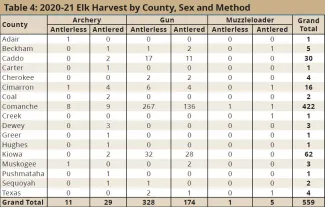
Pronghorn Hunting
Oklahoma’s pronghorn herd is relatively small compared to what is found in other western states. The state is on the eastern fringes of the pronghorn’s native range. However, Oklahoma’s herd is able to sustain a limited harvest in the fragile ecosystem that these one-of-a-kind creatures inhabit.
Pronghorn harvest opportunities include an over-the-counter archery license, once-in-a-lifetime controlled hunt permit, and landowner drawn permits.
Hunters managed to harvest 169 pronghorns from the open hunting area of Cimarron County and the portion of Texas County west of State Highway 136. Cimarron County, having much better habitat with a greater proportion of native shortgrass prairies than Texas County, led harvest with 117 animals, 71 of those being bucks. Texas County hunters harvested 52 total, which included 27 bucks. Table 5 shows a breakdown of harvest by county, sex and method.

Archery Success Drives Solid Bear Harvest
2020 turned out to be one of the best years overall for bear hunters, who harvested 72 bears combined during the archery and muzzleloader seasons.
Archery hunters harvested a total of 68 bears (41 males and 27 females) while the muzzleloader portion only saw four bears harvested (two males and two females).
“Hunters checked in some very impressive bears in 2020. I saw at least four that would easily go over 500 pounds, and several that were in the 300-pound range,” said Jeff Ford, Wildlife Biologist in the Southeastern Region. “Most successful archery hunters have become very patient waiting on the bigger bears before letting their arrows fly.”
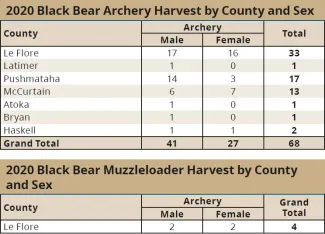
Oklahoma had its first bear harvested in Bryan County, one of the counties that had its first open bear season in 2019. Since the first bear season in 2009, hunting had been restricted to only the four counties in the extreme southeastern corner of the state. In 2019, the open area for bear season expanded to all or portions of 12 counties.
“I’ve seen a lot of trail camera photos from hunters in some the newly opened portions of the state and expect to see the harvest increase in those areas as hunters learn more about hunting bears,” Ford said.
The 2018 bear season set the bar for the most harvest success, with a total of 85 bears taken that year.
The 2021 season will be Oklahoma’s 13th for bear hunting. During the first 12 bear seasons, Oklahoma bear hunters have harvested 589 bears in total. Some Oklahoma bears have been very large, with several qualifying for Boone and Crockett listings, and many scoring more than enough for the state’s Cy Curtis big game record book. Ford said the heaviest bear he recalls being taken in Oklahoma tipped the scales at 638 pounds.
“We have had some very old bears harvested, one male around 20 years old. If you hold out and maybe let the young- er bears walk by, you could end up with a trophy of a lifetime.”
Ford expects 2021 to be another banner year for bear hunters. “We have had plenty of rain, and the mast crop in the portions of the open counties that weren’t hit by the late freeze in April are looking exceptional. Bear hunters who can take advantage of hunting near the season opener of archery season seem to be the most successful. The bears are really trying to put on the pounds before winter and unlike deer seem to move around more on warmer days.
“The best advice I can give to a hunter looking to fill a bear license on public land would be to look for acorns on the ground. If they can scout right before the Oct. 1 opener and find acorns with fresh bear scat around, they might start looking for a place to hang a stand. The bears tend to stay with a good food source until it’s gone that time of year. And be patient; the bears seem to show up at all times of the day.” All bear hunters must get either an archery or muzzleloader bear license before the opening dates of each season. Archery bear season dates are defined by statute, running from Oct. 1 until the third Sunday in October. Bear archery season has no harvest quota.
Bear muzzleloader season will be Oct. 26-Nov. 3, 2021, but the season will close as soon as a quota of 20 bears has been reached. Before hunting, muzzleloader hunters must call (888) 901-3256 for the latest bear quota information.